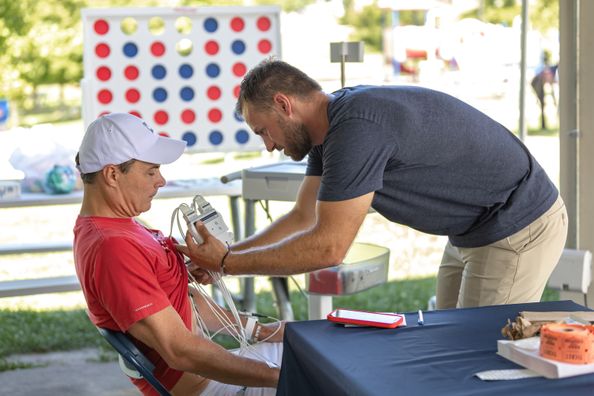Let’s be honest – getting a prostate exam probably isn’t the part of your yearly physical you look forward to most. And if you’re already not feeling great, the thought of a prostate exam might even make you a bit queasy. But checking on your prostate – and learning how to keep it healthy – is worth it.
The prostate is a small but powerful gland that sits below your bladder and in front of your rectum. It plays a key role in reproduction by adding fluid to semen that helps nourish sperm cells. While only about the size of a walnut, the prostate can cause big problems if it isn’t working correctly or if cancer cells develop there.
Prostate problems can happen at any age, but the risk goes up as you get older. With age, both the likelihood and the types of problems you might face tend to increase.
Here’s the 101 on prostate health as you get older.
In Your Younger Years: Prostatitis
Prostatitis happens when your prostate becomes inflamed. It is the most common urinary infection in men under age 50, and at least half of all men will deal with it at some point. While prostatitis can be uncomfortable, there’s no need to panic – it’s not cancerous and it does not increase your risk of developing cancer in the future.
There are four types of prostatitis:
- Acute bacterial prostatitis is a sudden infection caused by bacteria. It comes on quickly and needs prompt treatment.
- Chronic bacterial prostatitis is also caused by a bacteria. It can get better but then keeps coming back.
- Chronic prostatitis (chronic pelvic pain syndrome) isn’t caused by an infection. Instead, it leads to ongoing pelvic pain and urinary problems. The symptoms may come and go, or they may be long-lasting, recurring for months or years.
- Asymptomatic inflammatory prostatitis, also called nonbacterial prostatitis, happens when your prostate is inflamed but you don’t have any symptoms. It’s not linked to an infection.
Not all types of prostatitis need to be treated. If it’s caused by an infection, you will need an antibiotic. Chronic or asymptomatic inflammatory prostatitis doesn’t generally require treatment.
That said, chronic prostatitis can still cause discomfort. While antibiotics might not be needed, your provider may recommend other treatments, like prescription pain medications or pelvic floor therapy to help ease symptoms.
Also read: Men’s Health Tips: Questions to Ask Yourself
As You Get Older: Enlarged Prostate
Benign prostatic hyperplasia (BPH), also known as “enlarged prostate,” occurs when your prostate grows larger than normal. It is extremely common. BPH is the #1 prostate problem in men over age 50 and affects nearly half of all men by age 60.

More than 90% of men have an enlarged prostate by age 85.
Like prostatitis, BPH isn’t cancerous and doesn’t make you more likely to get cancer later. But also like prostatitis, BPH can cause problems that may affect your quality of life, including:
- Urinary symptoms, such as:
- Urinary retention, where you can’t completely empty your bladder
- Frequent urination, especially at night
- Straining or pushing to begin peeing
- Pain while peeing
- Blood in your urine
- Sexual problems, like pain after ejaculation
- Increased risk of prostatitis
- Bladder or kidney infections
It’s rare for BPH to cause symptoms before age 40, so you may have it when you’re younger without realizing it.
There is no cure for BPH, but don’t let that get you down – there are plenty of ways to relieve symptoms. Treatments can range from cutting back on alcohol to taking medication to shrink the prostate gland.
And As You Continue to Age: Prostate Cancer
Finding out you have cancer can feel isolating, but when it comes to prostate cancer, you’re far from alone. In fact, aside from skin cancer, it is the most common cancer among men in the US. About 1 in 8 men will be diagnosed with prostate cancer at some point. It’s more common in older men, with the average diagnosis happening around age 67.
In its early stages, prostate cancer doesn’t usually cause symptoms. As it grows or spreads, symptoms may start to appear, including:
- Difficulty getting or maintaining an erection (erectile dysfunction)
- Pain in the areas where the cancer has spread, like your ribs or hips
- Numbness or weakness in the legs or feet
- Loss of bladder or bowel control
- Feeling very tired
- Losing weight without trying
The good news? Prostate cancer is very treatable when caught early. Ninety-nine percent of men diagnosed before it spreads to other parts of the body will live at least five years after diagnosis.
The Great Debate: Prostate Tests
If you’re having symptoms, your provider may look for prostatitis or BPH. These conditions can even be diagnosed while you’re getting a test for something else.
When it comes to cancer, that’s where the good old prostate exam makes its entrance.
Prostate cancer screenings generally involve two tests. One is the digital rectal exam (DRE), where your provider gently puts their finger into your rectum to check for potential abnormalities.
The second is a PSA blood test, and that’s where things get a little tricky.
PSA tests measure a protein in your blood called “prostate-specific antigen” (PSA), which may indicate cancer if levels are too high. Since these tests can find cancer early, getting one might seem like a no-brainer. But there are a few risks, like false positives, which could lead to unnecessary treatments.
There are some differing opinions between experts, but most agree that the best thing to do is to talk to your provider.
Also read: What you should know about Prostate Cancer Screenings
Keeping Your Prostate Healthy
Prostate problems might typically affect older men, but there are steps you can take at every age to keep your prostate healthy.
One of the main ones is to keep up with regular testing. When you should start and how often you need exams depends on details like your individual risk factors. For many men, the recommendation is to test every year starting at age 50. Your provider can help you determine the best testing schedule for your needs.
Other steps include:
- Staying hydrated
- Limiting caffeine and alcohol consumption
- Eating a well-balanced diet high in fruits and vegetables and low in fat
- Not smoking
- Spending some time in the sun (too little exposure to the sun may increase your risk of prostate cancer)
Also read: Ways to Maintain Your Prostate Health
Whenever you notice symptoms like difficulty urinating or blood in your urine, don’t ignore them or wait for them to go away on their own. Talk to your provider so that you can determine the cause of your symptoms and what you can do to feel better.
Even if you don’t have symptoms, it’s never too early or too late to talk to your provider about getting regular prostate checks and keeping your prostate health intact. Schedule an appointment with a Quincy Medical Group primary care provider.
Health Topics:







